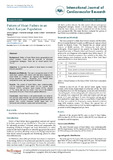| dc.description.abstract | Background:
Pattern
of
heart
failure
shows
geographical
and
ethnic
variation.
These
data
are
important
for
informing
management
strategies.
There
are
no
recent
reports
from
Kenya.
Objective:
To
describe
the
pattern
of
heart
failure
in
a
black
Kenyan population.
Materials
and
Methods:
This
was
a
prospective
study
of
116
adult
black
patients
with
clinical
and
laboratory
diagnosis
of
heart
failure
at
a
National
and
regional
referral
hospital
in
Kenya
between
January
–
November,
2011.
Patients
were
analyzed for cause, age and gender distribution.
Results:
The
causes
of
heart
failure
were
cardiomyopathy
(18.1%)
hypertensive
heart
failure
(15.5%),
vulvular
heart
disease
(12.9%),
ischaemic
heart
disease
(9.5%),
anemia
(7.7%).
Mean
age
was
52.2
years.
Over
40%
of
the
patients
were below 40 years. There was no gender difference.
Conclusion:
Heart
failure
is
still
predominantly
non
ischemic
but
coronary
heart
disease
has
assumed
greater
prominence
over
the
last
10-15
years.
It
affects
younger
individuals
with
no
gender
bias.
Control
measures
should
target
both
non
ischaemic and ischaemic causes and commence early. | en_US |

